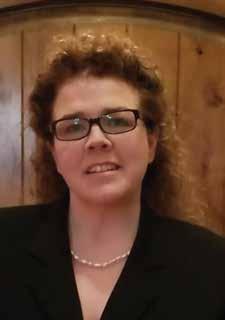
5 minute read
Shattering the Glass Ceiling
A Message from the President
Kimberly K. Moore Shattering the Glass Ceiling
Advertisement
Greetings!
I hope the New Year is off to great start for you. For those of you with New Year’s Resolutions, remember one day at a time. We are often our own worst enemy when it comes to setbacks so don’t get discouraged. Look to friends, family and colleagues to encourage and keep you motivated.
Last issue we focused on professionalism. This issue is devoted to Women in the Law. I thought it apropos to devote my article to three women I admire.
It’s no secret that women have traditionally faced more barriers to entry in their attempts to enter the legal profession.
But as the old saying goes, where there’s a will, there’s a way – and after jumping through countless hoops and skirting impossible legal boundaries, these women managed to shatter the stereotypes and reshape American law as we know it. Their enduring legacy says it all.
Ruth Bader Ginsberg
Few names in law are as influential as Ruth Bader Ginsburg. The second woman to ever sit on the United States Supreme Court. This peerless trailblazer scored major victories for women on hotly contested issues. PriortobeingappointedtotheUSSupremeCourt,many of her cases hinged on the Fourteenth Amendment’s Equal Protection Clause. In Reed v Reed (1971), a minor, Richard Lynn Reed, died and his mother wanted to be designated as administrator of his estate. Sally and her husband, Cecil Reed, had separated prior to the child’s death. Despite Sally filing a petition first, Cecil’s application was automatically approved because of an Idaho statute that stated that “males must be preferred to females” when there was more than one qualified person available to administer someone’s estate.
Relying on the 14th Amendment, Ginsberg argued that this violated the Equal Protection Clause. The Supreme Court unanimously agreed and struck down the Idaho statute. It was the first time the Court had ever applied the Equal Protection Clause to a law that discriminated on the basis of gender.
Ginsberg later argued that gender-based discrimination hurts men too in Frontiero v Richardson (1973). In an amicus brief, Ginsburg used the statute to argue against gender-based discrimination applied to men. She asked the Court during oral arguments “Why, did the framers of the 14th Amendment regard racial [discrimination] as odious? Because a person’s skin color bears no necessary relationship to ability. Similarly...a person’s sex bears no necessary relationship to ability.”
A plurality of the Supreme Court found the benefit policy violated the Constitution and argued that, because of the United States’ long history of genderbased discrimination, the court should use a strict standard of judicial scrutiny for laws that used sex as a classification.
Did Ginsberg always aspire to be a Supreme Court Justice? In an interview, Ginsberg spoke about to the number one question posed by young school girls. It starts with the dream because today for a young girl to aspire to be a judge is not outlandish. Contrast that to the day Ginsberg entered law school, where less than 3% of women comprised the legal profession.
Today about half the nation’s law students and more than one-third of our federal judges are women, including three of the current justices seated on the United States Supreme Court. Women hold more than 30 percent of law school deanships in the United States and serve as general counsel to 24 percent of Fortune 500 companies.
Sandra Day O’Connor
Like RBG, Justice O’Connor earned her law degree at a timewhenonlyatinyfractionofattorneyswerewomen. To say that the job market was hostile towards women in law would be an understatement. Law firms wouldn’t hire Justice O’Connor at first, but she persevered and found a job at the San Mateo County DistrictAttorney’s office… provided that she started with no pay at all.
Although herself a member of the strong conservative majority, O’Connor was not afraid of breaking ranks and made decisions that would be monumental for American women. Through her important role in Planned Parenthood of Southeastern Pennsylvania v. Casey (1992), the court readjusted its views on women’s abortion rights. The court’s opinion, which O’ Connorauthoredherself,reaffirmedtheconstitutionally protected right to abortion that was established under Roe v. Wade (1973) and lowered restrictions such as parental consent, waiting periods, and spousal consent.
Bar Updates!
• The interior remodel of the TCBAis progressing as scheduled. Demo has been completed and we are awaiting delivery of the materials.
• Membership numbers are doing very well at 2,048 members.
• The TCBF Golf Tournament will be held in May at
Meadowbrook.
• The C.A.P. Program is still looking for volunteers to assist on the FED docket. Please contact Beth
Nellis at bethnellis@cox.net to sign up.
Sonia Sotomayor
Justice Sonia Sotomayor had an embattled experience with the gatekeepers of the community and overcame challengingoddstobecomeajudge.Shewasdiagnosed with Type I diabetes and was told that she wouldn’t live past the age of 50. These bitter experiences only heightened her resolve to press onward to achieve her Despite dealing with hostility directed at women and minorities in general, Sotomayor graduated with honors in her class. She would fiercely defend the rights of the American people as an attorney, and a she remains a bulwark of individual liberty as a Supreme Court Justice. In a 2012 case, Justice Sotomayor protected privacy rights, ruling that the police could not attach a GPS device to a car without a warrant to monitoradriver’smovements.Inher2017term,Justice Sotomayor defended voter representation, dissenting against states that tried to purge registration rolls of minority, low income, disabled, and veteran voters.
My above three heroes of women in the practice of law demonstrate that gender does not, and should not, dictate the terms of one’s own path. Their contributions have, and will pave the way for generations to come. These serve as pioneering examples of the influence of women in law for now and in the future .
Happy Valentine’s Day!

Kimberly K. Moore TCBAPresident, 2020-2021

